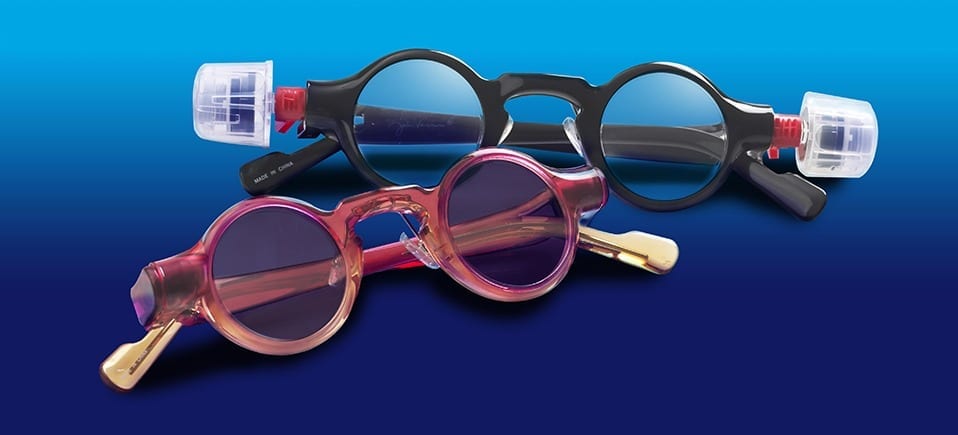
They have a more traditional goal: improving your vision.
If someone mentions the phrase “high-tech glasses,” you probably assume that person is talking about Google Glass, the smartphone-on-a-headband that Google hopes to offer for sale next year.
The truth is, though, that 2013 has been the Year of the High-Tech Glasses in other, quieter ways. At least three new eyeglass technologies have arrived. They’re not intended to bring the Internet to your eyeball. They have a more traditional goal: improving your vision.
Here’s a look at three.
ADLENS VARIABLE FOCUS Yes, it’s an unfortunate name; Adlens glasses may be the one place in today’s world where you won’t encounter advertising.
“Ad,” in this case, is short for “adjustable”; these are variable-focus glasses. The lenses of the Lennon and Hemispheres styles ($80 and $100; adlens.com) are filled with liquid, and cylindrical plastic knobs protrude from the sides. By turning the knobs, you precisely adjust the liquid pressure on a curved membrane inside the lens, affecting its power (from –4.5 to +3.5 diopters). They can handle even severe nearsightedness or farsightedness. They don’t work for the blurriness of astigmatism, but they’re perfect for presbyopia (better known as “over-40-reading-glasses-syndrome”).
There are distinct advantages to variable-focus glasses like these. First, you can tweak the lenses independently for each eye. Second, you can adjust them for different situations — tired eyes often need more help — or even different people. They’re a natural for restaurants, which can hand them out to patrons who’ve forgotten their reading glasses.
Third, you can adjust them yourself, without requiring an eye doctor or a prescription. That’s a big deal in poor countries like Rwanda, where, Adlens says, there are 10 million people but only 14 optometrists. Even though a million Rwandans need glasses, almost nobody has them, according to the company. When you buy a pair of these glasses, Adlens donates a pair for distribution in Rwanda.
The Lennon and Hemisphere styles look goofy because the lenses are perfect circles, like half dollars, which isn’t a design that will suit many faces. (They’re available in a wide range of frame colors and lens tints.)
Furthermore, the adjustment knobs are big, ribbed and absurd looking, sticking out beyond the frames. Once you’ve dialed up the perfect focus, you can snap off the knobs, but then the glasses are no longer adjustable. You’ve locked in that “prescription” forever.
You can leave the knobs on, so that you can dial up different focal powers at different times. That’s fine if you don’t care what you look like (at home in bed, say), but you wouldn’t want to wear them in public like that.
The third Adlens style, Emergensee ($40), is slightly more conventional-looking. Its adjustment knobs are much smaller and less conspicuous. They stay on, so you can always adjust the focus.
These glasses don’t have liquid inside; instead, each lens has two panes that slide past each other when you turn the knobs, so they still look a little odd. But Adlens promotes them as an ideal spare pair for the glove compartment or kitchen drawer.
The best, Adlens says, is yet to come. This fall, it will offer liquid-lens technology, for the first time, in normally shaped, designerlike frames. Stay tuned.
The Latest Bing News on:
High-Tech Eyeglasses
- Pair Eyewear Review: Can These Glasses Give You Rizz and Help You See?on May 10, 2024 at 1:00 pm
Enter: Pair Eyewear. You can save money by investing in just one frame, and adding pops of color and design with magnetic attachments that snap and attach to the "glasses" part of your glasses. These ...
- The 6 best places to buy prescription glasses online in 2024 and saveon May 10, 2024 at 12:17 pm
GlasesUSA.com is the place to shop for prescription glasses, especially if you're looking for designer frames (from Ray-Ban, Oakley, Prada, Coach, Versace, Gucci and 54 others) or low-cost generic ...
- Stanford tech may help the transition from Vision Pro to Apple Glasseson May 10, 2024 at 4:50 am
While an expensive, bulky Vision Pro headset undoubtedly has its place for some, Apple’s longer-term goal is believed to ...
- Did Stanford just prototype the future of AR glasses?on May 9, 2024 at 9:12 pm
Although the Stanford tech is currently just a prototype, with working models that appear to be attached to a bench and 3D-printed frames, the researchers are looking to disrupt the current spatial ...
- Gift ideas for graduates | What the Tech?on May 9, 2024 at 11:49 am
Graduation season is here for high school and college graduates so here are some tech gift ideas that could be a hit.
- Ray-Ban Meta Vs Viture One XR Smart Glasses: Which One Is The True Budget King?on May 8, 2024 at 3:00 am
Back in the day, you'd be chastised for standing too close to the TV. Now, techies are paying a premium to get high-definition video streamed a few centimeters from their eyeballs. Times have indeed ...
- Advancing vision: high-tech lenseson May 7, 2024 at 8:28 am
TAMPA (BLOOM) – Cataract Surgeon Brandon Rodriguez, MD with St. Luke’s Cataract and Laser Institute joins Gayle Guyardo the host of the nationally syndicated health and wellness show Bloom to talk ...
- Fender benders mean serious high-tech repairs nowon May 7, 2024 at 12:01 am
These days, it’s high-tech. Virtually every new vehicle sold in the last few ... Sometimes shiny black boxes are also embedded in the grille and what look like camera lenses are mounted behind the ...
- 10 High-Tech Gadgets That'll Keep You Entertained During Your Next Camping Tripon May 6, 2024 at 10:30 am
Keeping entertained while camping can be a challenge, whether the weather is uncooperative or you just get bored easily. These options may help spice things up.
- Even Non-Techy Folks Will Love the Ray-Ban Meta Smart Glasseson April 30, 2024 at 12:15 pm
I tried out the Ray-Ban Meta smart glasses, and found them to be perfect for taking photos and listening to music. Read my full review with photos here.
The Latest Google Headlines on:
High-Tech Eyeglasses
[google_news title=”” keyword=”High-Tech Eyeglasses” num_posts=”10″ blurb_length=”0″ show_thumb=”left”]
The Latest Bing News on:
Variable-focus glasses
- Pair Eyewear Review: Can These Glasses Give You Rizz and Help You See?on May 10, 2024 at 1:00 pm
Enter: Pair Eyewear. You can save money by investing in just one frame, and adding pops of color and design with magnetic attachments that snap and attach to the "glasses" part of your glasses. These ...
- The 6 best places to buy prescription glasses online in 2024 and saveon May 10, 2024 at 12:17 pm
GlasesUSA.com is the place to shop for prescription glasses, especially if you're looking for designer frames (from Ray-Ban, Oakley, Prada, Coach, Versace, Gucci and 54 others) or low-cost generic ...
- Vuzix Corporation (NASDAQ:VUZI) Q1 2024 Earnings Call Transcripton May 10, 2024 at 7:55 am
May 9, 2024 Vuzix Corporation isn't one of the 30 most popular stocks among hedge funds at the end of the third quarter (see the details here). Operator: Greetings, and welcome to the Vuzix First ...
- Serve up Style With These Pickleball-Inspired Fashions From Target, Lululemon, Halara, Spanx & Moreon May 8, 2024 at 2:04 pm
Whether you're looking to add a pop of pickleball panache to your daily attire or gearing up for a match on the courts, these pieces are a win for your wardrobe.
- Ray-Ban Meta Smart Glasses Vs Viture One XR: Features Comparison/Review Releasedon May 8, 2024 at 12:46 am
Precisionopticspro.com has published an article comparing the latest Ray-Ban Meta Smart Glasses and the Viture One XR Glasses. The two wearables are retailing under $500, offering feature-rich and ...
- Flex Focus Reviews [(Consumer Reports Experience) Do flex Focus Reading Glasses Work?]on April 15, 2024 at 6:34 pm
In light of that visible improvement in the eye care sector, we have chosen to shed more light on the Flex Focus adjustable glasses so that all its effectiveness or lack of it may be visible to ...
- 10 Best Glasses With Adjustableson April 15, 2024 at 5:00 pm
1x Foldable and Adjustable Play Stand, 6x Thumb caps. The high quality assesories kit for nintendo switch lite saves your money and time on searching varieties accessories. SOLID AND STURDY ...
- The best places to buy prescription glasses online in 2024on December 19, 2023 at 3:09 pm
It offers a small number of fashionable styles, but all with an activewear focus. With lightweight nylon frames, replaceable (and adjustable) nonslip nose pads and arm contact points used in all of ...
- Smart Eyeglasses That Auto Focus Where You Lookon February 3, 2017 at 11:20 pm
Technically, the glasses have a distance sensor embedded into the front of the frame and continually adjust the focus of the lenses ... but the adjustable lenses themselves.
- adjustable focus lenson February 3, 2017 at 4:00 pm
Technically, the glasses have a distance sensor embedded into the front of the frame and continually adjust the focus of the lenses. An 8 gram, 110 mAh battery powers the prototype for roughly 6 ...
The Latest Google Headlines on:
Variable-focus glasses
[google_news title=”” keyword=”variable-focus glasses” num_posts=”10″ blurb_length=”0″ show_thumb=”left”]











